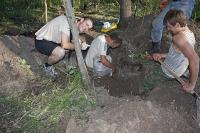Russian Soils for the World Soil Museum
‘A deep layer of dark black soil, with lots of holes made by moles and beetles’. That’s how ISRIC researcher Vincent van Engelen describes the new Chernozem soil sample from Russia. Working with scientists from Moscow State University, ISRIC collected soil samples and monoliths from seven sites along a North-South transect of about 1000 kilometres, stretching from Moscow to Volgograd.
 The Dutch and Russian soil scientists (Nikolay Rybalskiy) described, sampled and photographed the sites this summer; next they will analyze the samples. One of the most impressive sites yielded this fertile Chernozem soil, which stretch for thousands of square kilometres in Russia. ‘Chernozem soil is typical of the long-grass steppe regions of the world’, explains Vincent van Engelen.
The Dutch and Russian soil scientists (Nikolay Rybalskiy) described, sampled and photographed the sites this summer; next they will analyze the samples. One of the most impressive sites yielded this fertile Chernozem soil, which stretch for thousands of square kilometres in Russia. ‘Chernozem soil is typical of the long-grass steppe regions of the world’, explains Vincent van Engelen.
Six monoliths were brought back to add to the ISRIC World Soil Museum collection. The new monoliths – transported in boxes measuring 1.5 metres in length - will join the 1100 monoliths ISRIC has already collected since 1974. Together with soil samples, the monoliths are references of the major soils of the world. However, some soil types and regions, including Russia, are currently under-represented, so new missions can help students and other users of soil information to gain a more complete picture of the different soil types.
Map with sampling locations of Russian monoliths
The sites that the team visited provided classic examples of soils that develop on loess deposits as well as some examples of ‘intrazonal soils’. First described by the Russian soil scientist W.W. Dokochaiev in the 19th century, intrazonal soils are interesting because they are strongly influenced by local conditions other than climate. Unlike most soils they cannot be attributed to any one of the earth’s major climatic belts. The team found soils ranging from Luvisols and Chernozems to Kastanozems, and from Gleysols, Solods(Planosols) and Solonetz to Solonchaks. Preparation of the monoliths for display in the museum is planned for the coming months.
The mission is part of the Expansion of the ISRIC World Soil Reference Collection project. During the coming three years, ISRIC will enlarge its current soil reference collection with another 100 profiles. These will come amongst others from Russia, Chile, the Netherlands and Morocco. All information on the reference profiles will be added to ISRIC's WOSIS database that is freely accessible through the ISRIC website.